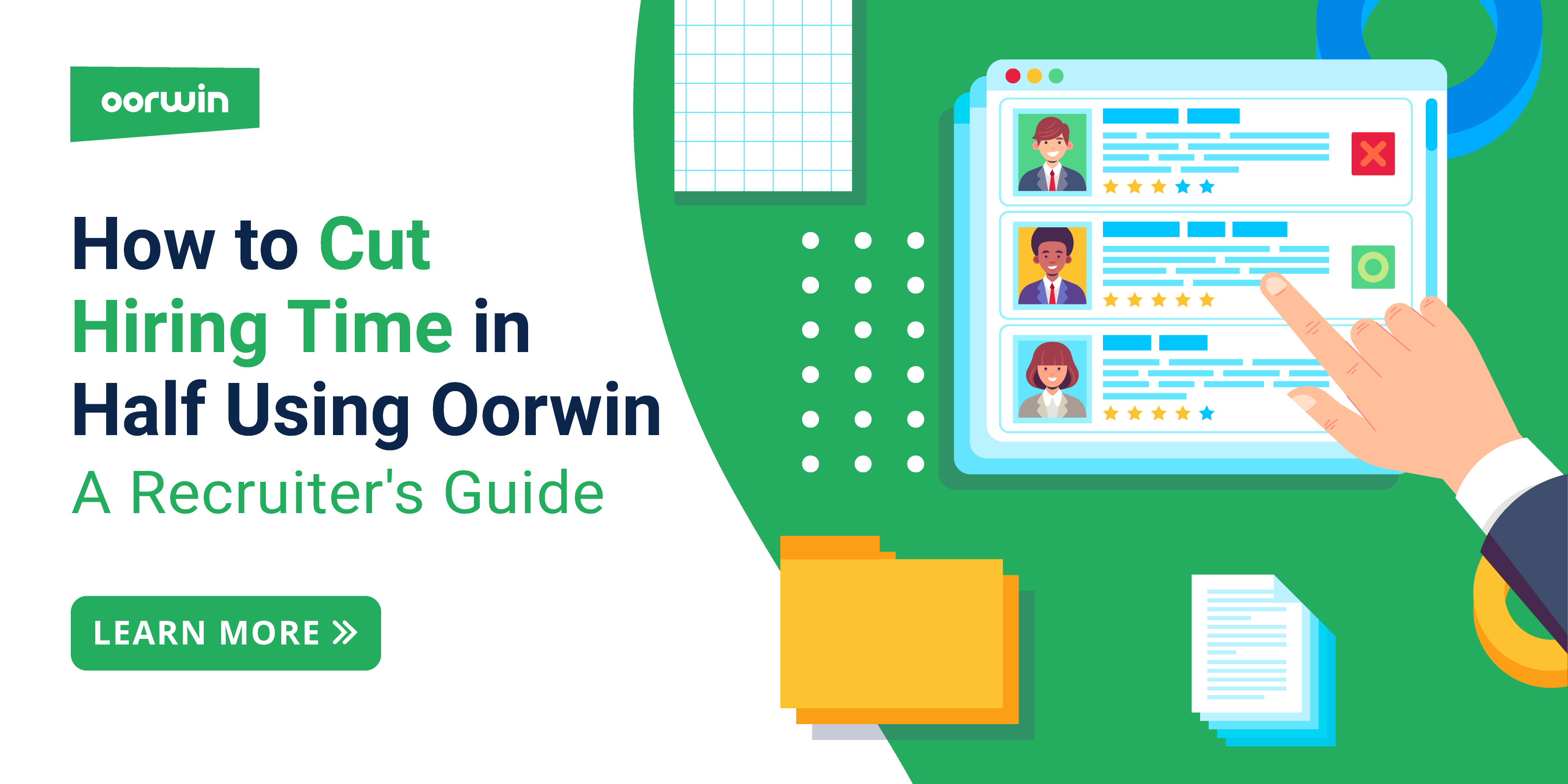Recruiting Passive Candidates: Key Strategies and Insights
Oorwin
1min read / 11 Aug 2022

Related Articles
The Art of Recruiting Passive Candidates: A Comprehensive Guide

Today’s job market is a puzzle for HR leaders, with a labor shortage affecting a staggering two-thirds of them globally. In the U.S., the challenge is even more pronounced: there are twice as many job openings as there are job seekers, and attracting top talent has become a hurdle for 61% of business leaders.
The solution?
Recruiting passive candidates. Making up 39% of the talent pool, these individuals aren’t actively job searching. Still, they could be swayed by an appealing role, offering a unique opportunity for employers to strengthen their talent acquisition strategy.
What Is a Passive Candidate?
The term “passive candidate” describes people who are satisfied with their jobs and are not actively looking for new ones. A quality marketing recruitment technique, such as inbound recruiting, can be used for recruiting passive candidates.
The phrase “passive applicant” was created to refer to a target audience of potential candidates who do not submit their applications. These are frequently accomplished people with highly sought-after expertise and skill sets.
With 45% of the workforce not looking for a new job but willing to discuss a new opening, proactive sourcing, like social networks, will be your best bet for recruiting passive candidates. Different types of candidates have different interest levels, so your recruitment strategy must be specific to find, recruit, and hire the best candidates effectively.
Why Recruit Passive Candidates?
Recruiting passive candidates is a strategic move in today’s competitive job market. These candidates, often content in their current roles, bring valuable skills and experience. By recruiting passive candidates, companies can tap into a pool of high-quality talent that needs to seek new opportunities actively, reducing the time and resources spent on extensive candidate searches and training.
Top 10 Strategies for Effectively Recruiting Passive Candidates
Recruiting passive candidates is typically more difficult as they are happier in their current role than active candidates, meaning it will take more work to win them into your company. However, they are still open to better opportunities.
1. Take Advantage of AI Tools for Sourcing, Screening, and Matching
Artificial intelligence (AI) tools, like candidate sourcing, screening, and matching, can quickly improve a recruiter’s ability to recruit passive candidates. These tools integrate with platforms to help recruiters seek to engage passive candidates based on specific criteria, quickly delivering the ideal candidates right to the recruiter’s inbox. When choosing an AI-enabled recruitment solution for sourcing passive candidates, be sure you can accomplish the following:
- Quickly find internal candidates using AI-powered matching
- Locate resumes of candidates through AI-powered resume harvesting from famous job boards
- Quickly find internal candidates using AI-powered matching
- Use AI-powered Symantec search to locate internal candidates
- Intelligently match jobs to candidates and candidates to jobs using custom algorithms
- Uncover similar candidates using AI-based matching
- Uncover internal candidates who had been considered for similar jobs
- Pull matching jobs from external sources for recruiting passive candidates using AI ranking and matching
2. Leverage Social Platforms for Recruiting Passive Candidates
The best way to recruit passive candidates is through social media platforms. Recruiters can join these communities and engage passive candidates to find those who would be an excellent fit for their open roles.
- LinkedIn: You can use LinkedIn to recruit passive candidates in several ways. For example, you can search for keywords related to their industry or companies that employ similar candidates. You can also use LinkedIn’s advanced search features to find candidates who meet specific criteria.
- Facebook: Recruiters can use Facebook’s targeted search features to find high-quality candidates you may otherwise miss. According to Glassdoor, Facebook is a great way to connect and source passive candidates who may not respond on LinkedIn.
- Twitter: Recruiters can find ways to recruit passive candidates on Twitter via marketing-specific keywords and hashtags.
Ensuring that your recruiting solutions integrate with these platforms is also essential. For example, Oorwin clients worldwide have successfully integrated the Oorwin ATS with LinkedIn.
3. Focus on Building Trust
Recruiters expect their candidates to have tailored CVs for open jobs. That works both ways. You have a bigger chance of winning, engaging, and recruiting passive candidates when they see your dedication to their needs. Focus on tailored ways to build trust and confidence with each engaging passive candidate. These include understanding their skills, hobbies, and professional development interests. Ask questions that get to the heart of their career goals:
- What do you enjoy most about your current role?
- Are you fairly valued at your company?
- How do you interact with your manager?
- What are your long and short-term goals?
4. Entice Passive Candidates
A crucial way to recruit passive candidates is by showcasing what they will gain by working with you. This is important because they may already be comfortable in their current job and location. Gently let them know how this new position will benefit them. Another way to entice candidates is by highlighting your company’s culture. A few ways to do this include:
Showcase company culture. Branding could include videos, social media, photos and images, articles, or podcasts.
Highlight civic responsibility. Sponsoring charity events, taking initiatives to reduce your environmental impact, and publicly showing that your organization is committed to positively impacting society can help you build a good reputation as an employer.
Emphasize your DEI focus. More than half of job candidates say a diverse workforce is paramount when deciding which companies deserve their applications. Your employer brand should reflect your commitment to DEI initiatives.
5. Use a CRM
Finding and recruiting passive candidates is a challenge. But it doesn’t have to be. Engaging with prospective employees correctly can help you source the best talent. A CRM (customer relationship management) software system can allow this.
A CRM tracks all passive candidate contact information and any notes about the conversation. Using this software will help you avoid duplicating your efforts and ensure that you remember all potential leads when recruiting passive candidates. It also allows you to understand which passive candidates might be open to new opportunities in the future.
6. Set up a Referral Program
The best way of recruiting passive candidates for recruiters is frequently current employees. Recommendations have long been a cornerstone of contemporary recruiting techniques, and for a good reason. According to studies, referred employees outperform non-referred hiring by up to 15%.
Each of your employees is connected personally and professionally through their networks. Additionally, these networks frequently include a lot of excellent candidates who could be a match for open roles at your business. However, passive candidates are significantly more likely to consider an opportunity presented to them by a personal connection than they are to reply to a communication from a recruiter.
7. Keep up with the industry developments
Recruiters might find more passive candidates by being aware of industry developments. It streamlines the procedure by generating alerts for events like mergers and acquisitions, recruiting intentions, layoffs, new projects, etc. Any upheaval or unpredictability could prompt workers to consider leaving their current positions. Even if the news doesn’t directly affect the prospect, passive candidates will see recruiters familiar with their sector more favorably.
8. Convey personalized sourcing emails
Most passive candidates are content with their positions. They aren’t aggressively looking for new ones because of this. Gaining their trust and directing their interest are the only ways to get them to break out of their routine. Both tasks cannot be accomplished by a general email that may have been distributed to hundreds of recipients.
When recruiting passive candidates, personalized emails demand more thought. To save time, you could employ a general template. However, the email’s body should discuss what brought you to a candidate’s profile in the first place. Mention how their (particular) accomplishments relate to the position or business you’re looking to source for – just enough information to get a conversation going.
9. Offer candidates a work-life balance
Nowadays, passive candidates are more inclined towards a position with remote working policies rather than higher pay. This differentiates them from active and passive candidates, as they prioritize work-life balance more.
Employers unwilling to provide staff members additional flexibility, whether through a wholly remote position or a hybrid work arrangement, are likelier to lose out on top-tier recruiting passive candidates. According to a survey, 72% of respondents said their family’s safety and protection are priorities. They are seeking employers who will safeguard their overall well-being.
10. Include opportunities and possibilities for advancement
According to a poll by Koan, a goal-setting platform for teams- Employee engagement and communication are essential for maintaining employees’ motivation in their jobs. Engaged staff members are:
They are more likely to achieve their goals if they are involved with the company mission.
If satisfied with their direct manager, team members are more likely to progress toward their goals.
If people believe their job counts, they are 7x more likely to produce work they are proud of.
You can learn more about what an “amazing opportunity” might be for possible new workers by researching them.
How to Effectively Engage Passive Candidates through Strategic Recruitment
Engaging and recruiting passive candidates involves a proactive approach where recruiters actively reach out to top talent who aren’t necessarily seeking new opportunities. This method focuses on relationship-building, aiming to gradually convince these candidates to explore career possibilities with your organization.
For effectively recruiting passive candidates, recruiters utilize a mix of tools and strategies:
- Implementing targeted social media and email marketing initiatives.
- Using Applicant Tracking Systems (ATS) and various HR technologies.
- Leveraging AI-powered recruitment tools for efficient candidate identification.
- Capitalizing on employee referral programs to tap into existing networks.
- Networking at professional events and conferences to make direct connections.
Oorwin’s AI-enabled ATS has been designed considering all recruitment needs, a comprehensive solution that can help organizations meet hiring swiftly.
Book a free demo today to evaluate it yourself.
Benefits of Recruiting Passive Candidates:
There are several advantages to recruiting passive candidates who are not actively seeking a job but who are open to opportunities. Some of these benefits are:
- Experienced and Insightful: Passive candidates bring valuable industry insights and experience from their current roles, allowing for a deeper understanding of market dynamics and trends.
- Long-Term Retention: Passive candidates are more likely to stay long-term when aligned with company values.
- Ready to Contribute: With proven ability and competence, passive candidates adapt quickly to new roles, enhancing productivity.
- Reduced Training Needs: Recruiting passive candidates often requires less training, as they already possess the necessary skills.
- Informed Hiring Decisions: Passive candidates provide detailed work histories, allowing for thorough assessment and smarter hiring choices.
- Network Expansion: Recruiting passive candidates can broaden your professional network and lead to further industry connections.
- Brand Enhancement: Actively recruiting passive candidates showcases your commitment to talent development, boosting your employer brand.
- Succession Planning: Utilizing passive candidates in critical roles aids in effective succession planning, ensuring smooth transitions in key positions.
Discover the potential of advanced candidate assessment with Oorwin. Click here to book a free trial and unlock innovative tools. Elevate your recruitment process today!
Challenges in Recruiting Passive Candidates
While recruiting passive candidates offers numerous benefits, it also presents unique challenges that employers need to navigate. These challenges include:
- Locating Passive Candidates: They often don’t actively showcase their resumes or apply for jobs, making it hard to find them.
- Overcoming Loyalty to Current Employers: Passive candidates may be reluctant to leave their current jobs due to loyalty and the perceived risks of a new work environment.
- Competitive Market: The high demand for passive candidates in a competitive job market makes it difficult to stand out.
- Limited Online Footprint: Some passive candidates have minimal online presence, complicating background and skill research.
- Lengthy Hiring Processes: Passive candidates might be deterred by cumbersome and slow recruitment processes.
Strategies for Recruiting Passive Candidates
Implementing effective strategies is essential for overcoming unique challenges and successfully recruiting passive candidates.
- Leveraging Employer Brand: Enhance your employer brand and digital presence to attract passive candidates.
- Building Relationships: Focus on one-on-one connections to build trust and overcome loyalty to current employers.
- Differentiating Your Offer: Stand out in a competitive market by highlighting unique company benefits and culture.
- Personalized Outreach: Tailor your communication strategies to engage candidates with limited online presence.
- Streamlining Recruitment: Simplify and expedite the process of recruiting passive candidates to appeal to passive candidates.
Take Your Passive Candidate Recruitment to the Next Level with Oorwin
As we wrap up this comprehensive guide, remember that the key to successful passive candidate recruitment lies in a balanced approach of technology, personalization, and strategic outreach. Oorwin stands ready to empower your recruitment efforts with cutting-edge tools and insights.
Take the first step towards revolutionizing your talent acquisition process – discover Oorwin’s innovative solutions now.
Frequently Asked Questions
What is a passive candidate in recruitment?
A candidate under consideration by an employer for a particular position but not actively looking for a new job is known as a passive candidate. Passive candidates have yet to apply for any vacant positions and are not looking for work.
What are the benefits of recruiting passive candidates?
As passive employees are not hunting for other opportunities, there is less pressure to decide immediately. As a result, there will be a little rivalry to employ that top talent, and recruiters will have plenty of time to make rational data-driven choices. In contrast to active candidates, passive candidates already have a job and skills; therefore, they won’t embellish the qualifications on their resumes. Thus, the need for honesty and openness to foster trust will grow.
How can I find passive candidates?
You can find passive candidates through various methods, such as leveraging social media, attending industry events, using AI-powered tools, implementing employee referral programs, and building your employer brand.
What strategies can I use to engage passive candidates?
Only passive candidates respond to traditional outreach such as networking, job postings, and recruitment ads. They are more likely to be attracted to and actively target companies with desirable cultures and core values that align with their ambitions. For this reason, building a strong employer brand to attract the best passive candidates is among the most effective avenues of approach.
Popular Articles..
Blog

9min read / 25-Jun-2025
Master Effective Interview Techniques with Oorwin: A Step-by-Step Recruiter’s Guide
Blog
Blog
Get the latest Oorwin releases, updates, success stories & industry news
 Back
Back


